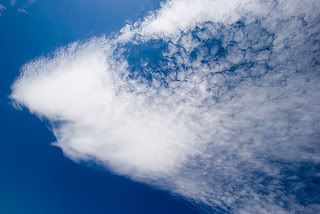A saved entry from Tuesday, 20/19/07
It was another boiling day today, too hot to visit the duckpond for most hours. The temperature started to cool down in the afternoon, however, so Mantichora and I decided to see if the wood ducks had returned.
Upon our arrival, it started to rain! Finally! I was worried the birds would shelter in the rain or it would be difficult to photograph them, but it was only spitting and I soon spotted two Midlings were feeding around the ‘shore’* (the other was standing on a rock near that cycad) and there, Mantichora met the new black ducklings for the first time.
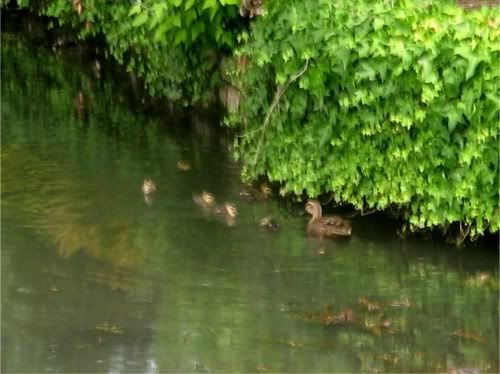
At this point I wondered where the Cutiechicks were, and started looking for them. Maybe they were resting on the island, as I’d seen the Midlings do when they were smaller. If they were, they were hidden (not exactly with difficulty, considering their size and the amount of plants).
As I made my way round, I saw a baby sparrow following its father around, begging for food. The way they do that is so cute! The dad-sparrow tried to get away from it and was forced to take flight, with the chick chasing it.
The black duck family appeared again, one adult and eight chicks. I was watching them when suddenly, the adult attacked one of the babies!
Now, I know black ducks are aggressive, and I’ve seen parent birds in general ‘discipline’ their young. For a moment I thought this was happening, but something was wrong. The adult chased the duckling, as the occasional ones do to the Snuggleducks (the original black ducklings I visited), but instead of a nasty peck, it bit again and again, clearly aiming for the neck and trying to hang on. The poor, shrieking duckling was absolutely helpless, and so tiny that the duck managed to lift and thrash it from side to side. By the neck.
All of this happened within seconds, and I panicked and tried shouting and stomping at the water’s edge, bluffing a charge to scare it off. It gave a split second of distraction for the duckling to get away, and the adult immediately chased. I threw a stick at it and it left. The rest of the ducklings followed closely behind; meanwhile, the little outcast disappeared between the lily pads. 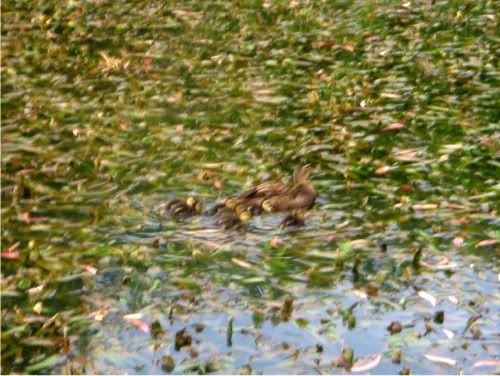
I watched the seven remaining ducklings go, worried, but was distracted when this bird landed nearby: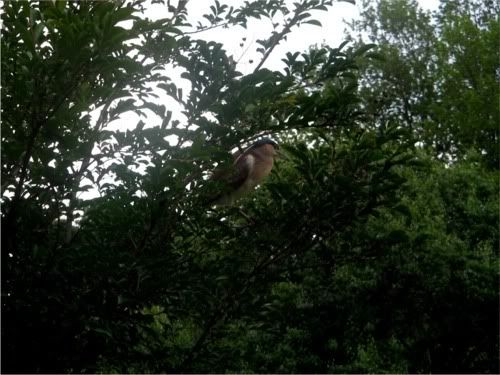
It was the second time I had seen it, and it let me come within a few metres. What bird it is, I didn't know at the time, but later found out was a nankeen night heron, in its breeding plumage.
Mantichora met up with me at this point, and I showed him the black duck family, who looked okay until the adult started to attack another duckling! I scared it off, luckily, but now there were two ducklings separated from the flock. We could hear them cheeping loudly on the edge of the island while the rest of the family swam in the opposite direction, with only six ducklings left. They were alive, but without a family, for how long?
The whole thing was really upsetting. Mantichora and I tried to come up with an explanation. I expressed my fear that there must be a reason for such high numbers of babies (a high mortality rate – but at the hands of their own parents?), and he suggested that there might be more than one black duck family here. We saw more vicious fighting between adult black ducks – one even attacked the heron! – which made me wonder… until we saw the other black duck family, coming back ‘round from where the cheeping outcasts were! Mantichora was right!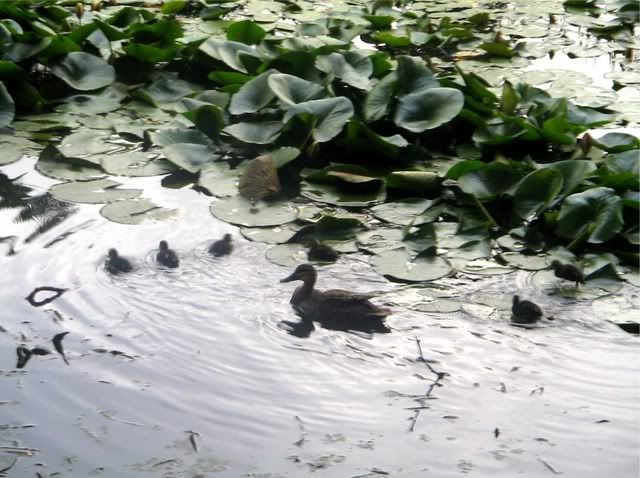
Well, that explained a lot. I still felt awful knowing that that other duck would have killed two helpless babies just because they apparently weren't its own, but at least they had a family to return to who would protect them.
There are actually nine ducklings in this family, making fifteen ducklings. No wonder there is so much fighting (yes, it continued today - one duck even attacked the heron! ); two families competing for the same territory and trying to protect their young at all costs.
We headed back after that. We didn’t visit the Snuggleducks; we’d had a bit too much for one day to head over to their pond as well. There was no sign of the Cutiechicks, who were probably on the island, or the wood ducks, who I had hoped to photograph, having missed them yesterday. We did see a wood duck,at least; a lonesome adult female: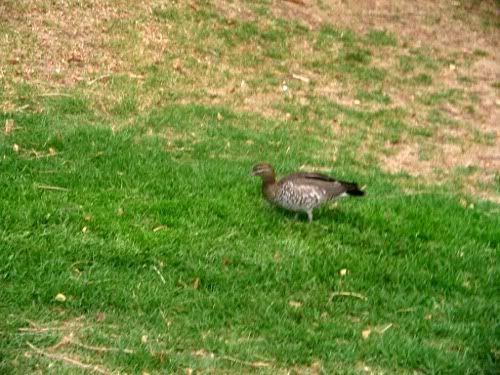
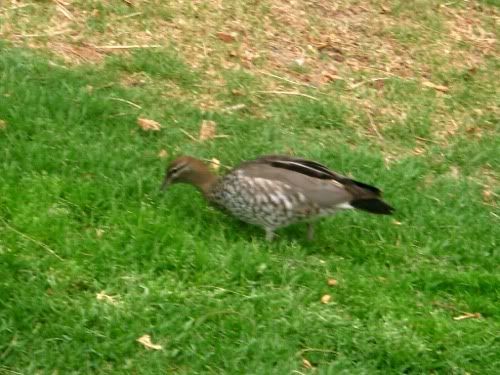
* The ‘shore’ is the part of the pond where someone appears to have dumped a large pile of stones, etc at least a year ago (that’s not necessarily what happened; that’s just my explanation), and the eroded result is the most natural border of the pond (the rest is abruptly cut off with bricks). Birds love to wade around this small area. A flock of mynas or starlings bathing here is a common sight; clearly, they feel safe here, despite its close proximity to chairs and a footpath.
Thursday, November 22, 2007
Black Duck Nastiness and Confusion
Posted by
Cloudfish
1 comments
![]()
Labels: cutiechicks, midlings
New Chicks
A saved entry from Sunday, 18/11/07
It had been almost a week since I last visited the duckpond, and I knew I had to get photos, fast! I knew from watching the Midlings grow that the new baby Cutiechicks would not look like this for long. So even though it’s the middle of a heat wave, I decided to find them. Plus I had an art interview tomorrow I had been preparing for all week and I wanted to take some photos for it and also needed a distraction.
First I visited the Snuggleducks. They were still stuck in their own little pond, though they were about fully grown and probably capable of flying out. Maybe they are just happy in their pond. They'd better learn soon, though, since the water is the lowest it's ever been and summer hasn't even started. 
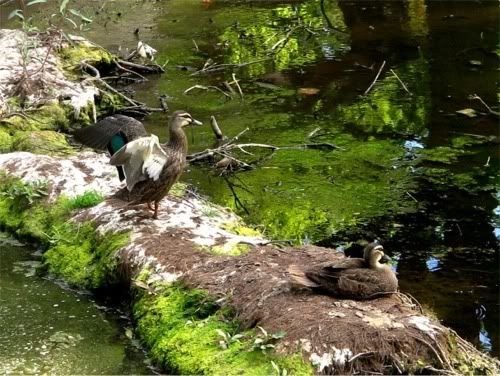
As you can see, their wings are fully grown. Their tail feathers aren't as neat as an adult's, though.
Like the last time I took pictures of them, there was an adult black duck* visiting the pond who occasionally chased them to give them a peck!
Then: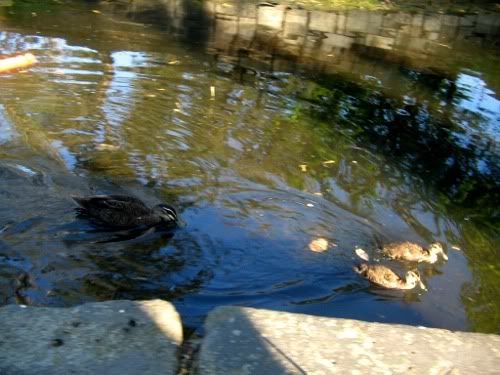
Now: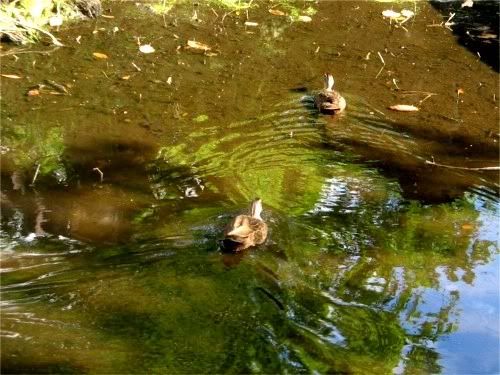
Note the direction and strength of the ripples.
I got in some other photographers' way capturing this duck on camera:
Wait a minute…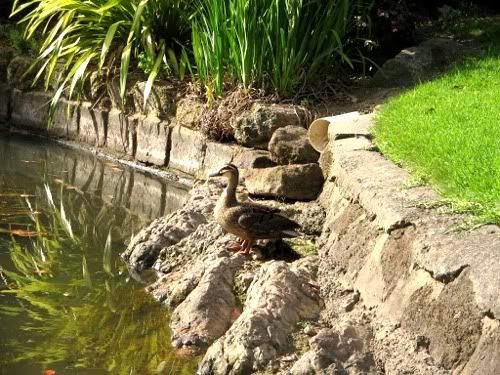
Is that…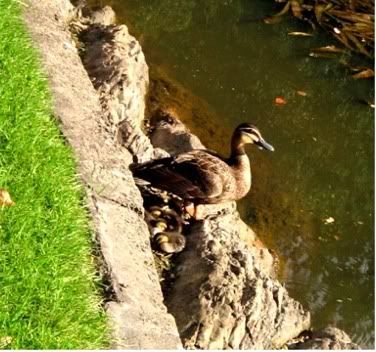
BABY DUCKLINGS!
They must have only hatched in the last few days!
There was a lot of rather vicious fighting between adult black ducks, which might have something to do with the new ducklings. But strangely, although I've seen them attack ducklings before, these ones left the babies alone! One 'mother duck' would be with the ducklings before being swooped, crashed and chased away in flight by another duck, while the ducklings remained untouched.
I found some moorhens: an adult, two Midlings, and a Cutiechick! I was in an awkward position to photograph them; standing on the edge of the bank, leaning over, camera in one hand and the other holding cycad leaves back.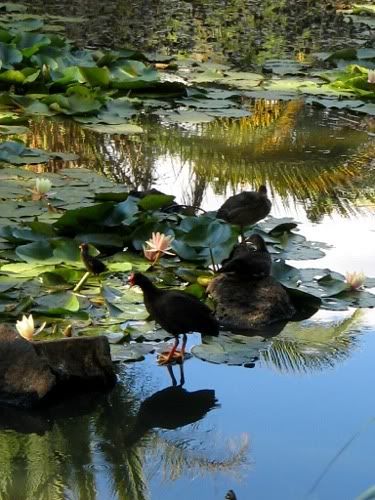
The chick had grown feathers over its previously balding head, but its ‘finger’ wings were still bare red. Gorgeous! Meanwhile, the other Midling was spotted a few metres away. The Midlings are so independent now, and big, especially compared to the tiny Cutiechick.
The adult was vary wary of this cormorant, who ignored it and let another moorhen literally brush past without batting an eye.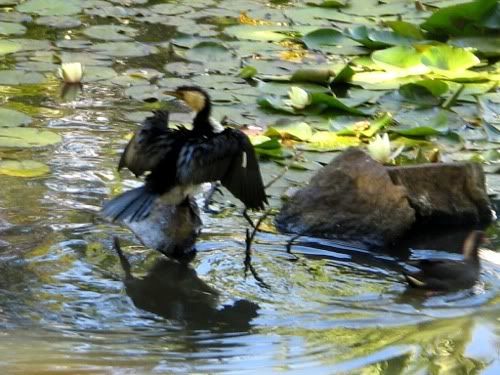
But where were the other three Cutiechicks? I began to look for them and found the cheeping black ducklings! There are eight of them; that’s a lot to look after.
Bye, ducklings.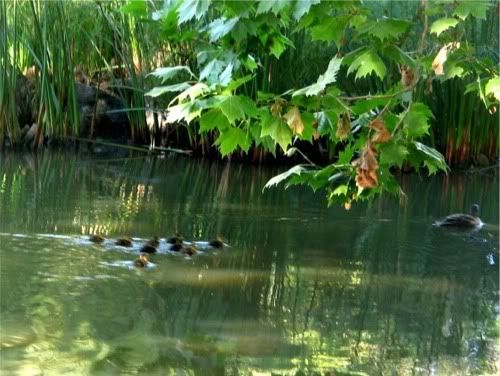
Hello, two other Cutiechicks! (They're under the lilies in the centre)
Though supervised by another adult, the one spotted before came right away when they started cheeping, with the first Cutiechick following closely behind. 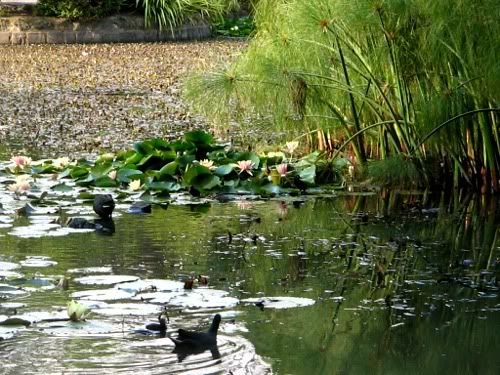
The adults feed the young'uns.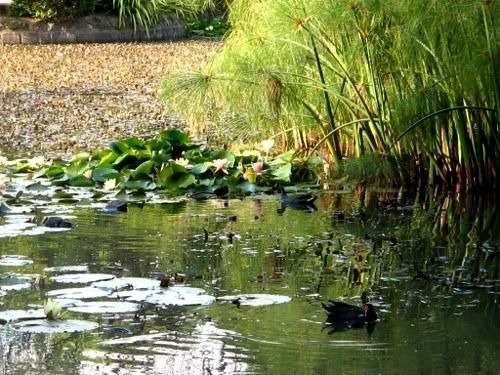
Bye, moorhens and Cutiechicks. 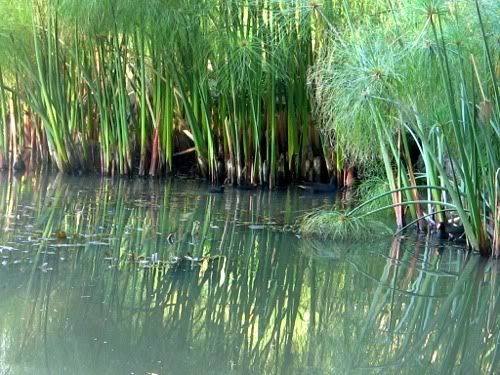
Unfortunately, that leaves one Cutiechick unaccounted for at this point. I hope it's okay.
There was no sign of the wood ducks today either (though I feel they are probably safe), so I haven't been able to photograph them. They were there last week!
* Pacific black ducks are not black; they are the common brown duck you see in just about every freshwater body. I don’t know which idiot decided to call them that. Why not ‘Pacific brown duck’?
Posted by
Cloudfish
5
comments
![]()
Labels: cutiechicks, midlings, snuggleducks
Tuesday, November 20, 2007
Baby Bird Diary's First Entry!
Hello, and welcome to the Baby Bird Diary. Here I will attempt to document the weekly happenings of the young waterfowl at two duckponds I like to visit. 
In fact, concern about the Snuggleducks’ survival initially prompted my boyfriend Mantichora and me to check up on them (the pond provided them with plenty of food, sun and shade and protection). Then the relaxing time the park held for us, where we could enjoy the fresh air and relax on the grass while watching the wildlife, plus the charm of the baby birds, drew us back. Okay, mostly me. And mostly because of the baby birds.
The photos I took that day were a reminder of how quickly the baby birds grow, since they never looked the same the next week. By the time I got back to the pond having remembered to get new batteries for the camera, then new batteries that worked, then remembered to bring said camera, the Snuggleducks, Midlings and wood ducklings were nearly grown. I realised I should have started such a project when I could document their growth (and survival) from the earliest stages, and decided to wait until the next breeding season, assuming I was still interested by then.
That was about when Mantichora pointed out something to me in the main pond. Or rather, four little things. Tiny baby moorhens! Since we had last visited only two days before, we knew these birds were newly hatched. We named them the Cutiechicks, and since there were now two sets of moorhen chicks, we named the older ones the Midlings. It was so fascinating, watching them follow the adults around, cheeping, and they were fed by both the adults and the Midlings! Fluffy little things gave me the perfect opportunity to start this blog I'd been putting off.
And thus the Baby Bird Diary began.
Posted by
Cloudfish
16
comments
![]()

